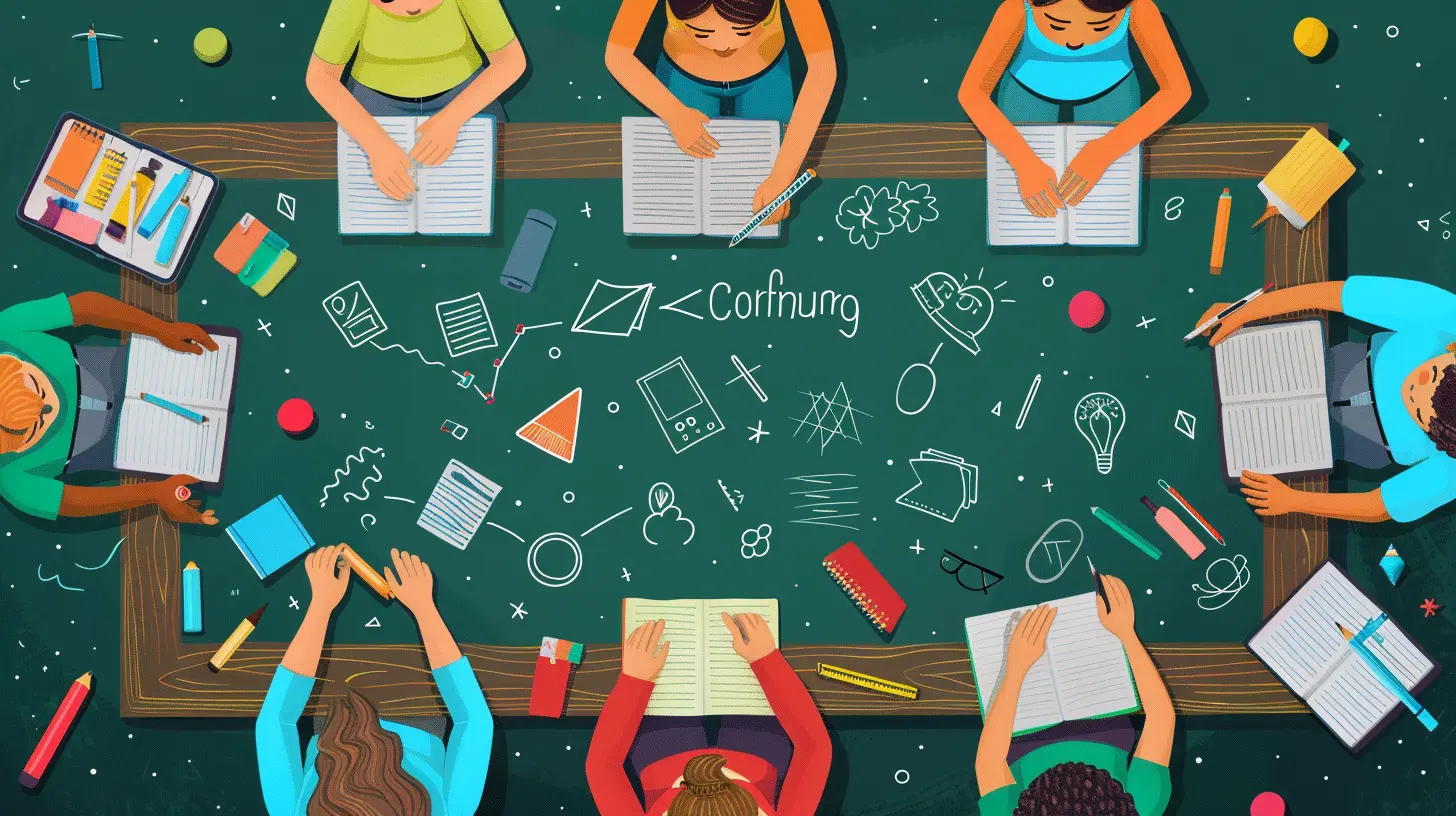How Co-Teaching Can Enhance Collaborative Learning
3 November 2025
Let’s be honest—teaching can get lonely. One adult in front of 30 students trying to juggle different learning styles, needs, and abilities? It's kind of like juggling flaming bowling pins while riding a unicycle. That’s where co-teaching steps in and saves the day.
You’ve probably heard the term tossed around in educational circles, but what exactly is co-teaching, and more importantly, how does it enhance collaborative learning? If you're a teacher, administrator, or even a curious parent, this is your go-to guide. So grab a cup of coffee, and let’s delve into the world of co-teaching and its magic on collaborative learning.
What Is Co-Teaching, Really?
At its core, co-teaching involves two or more educators working together in the same classroom to plan, instruct, and assess a group of students. This isn’t one teacher leading while the other is just there to "help out." Nope. It’s a true partnership—like Batman and Robin, but with lesson plans.Co-teaching can take many forms:
- Team Teaching: Both teachers share equal responsibility in delivering instruction.
- One Teach, One Support: One teacher leads while the other floats to assist students.
- Station Teaching: The classroom is divided into stations, each run by a teacher.
- Parallel Teaching: The class is split into smaller groups, each taught the same material separately.
- Alternative Teaching: One teacher handles the large group, and the other works with a small group that needs extra help.
Different styles, same goal: better learning for all students.
Why Collaborative Learning Matters
Before we dive into how co-teaching enhances it, let’s talk about why collaborative learning is worth the hype.Collaborative learning encourages students to work together toward a common goal. It’s about pooling ideas, solving problems, and learning from one another. Think of it like a potluck dinner—each person brings something to the table, and everyone leaves full.
When students collaborate, they:
- Develop critical thinking skills
- Learn effective communication
- Build empathy and understanding
- Remember content better
- Feel more engaged and connected
Now imagine if the teachers were modeling this collaboration. Yep, that’s where the magic begins.
How Co-Teaching Boosts Collaborative Learning
1. Modeling Teamwork at Its Best
Students learn a ton just by watching. When they see two educators planning lessons together, sharing responsibilities, and bouncing ideas back and forth, it sends a powerful message: “Teamwork isn’t just encouraged—it’s essential.”This model empowers students to mirror that behavior in their group work. Instead of thinking, “I’ll do it all myself,” they begin to see the value in leaning on others and combining strengths.
2. Addressing Diverse Learning Needs
Let’s face it: no two students are the same. Some are visual learners, some prefer hands-on activities, and others need a bit more support to grasp the concepts. Co-teaching allows for flexible grouping and differentiated instruction—so every student gets what they need without feeling singled out.For instance, while one teacher leads a discussion, the other can monitor student understanding, provide one-on-one help, or pull a small group aside for reteaching. This dynamic environment encourages students to support each other too, making collaboration not just a method—but a mindset.
3. Creating a Supportive Learning Atmosphere
Ever noticed how a room feels different when there's more than one adult truly invested in the students? With co-teaching, students feel safer to speak up, share ideas, and even make mistakes (which, let’s be real, is where real learning happens).Having two teachers in a room means twice the encouragement, twice the feedback, and twice the celebration of student success. It changes the classroom dynamic into one where everyone’s in it together.
4. Facilitating Richer Group Work
With two educators in the room, it's easier to manage and guide group work effectively. Want to try a project-based learning activity or a debate? You’ve got the support to make it happen. Co-teachers can float between groups, ask questions, offer guidance, and assess engagement in real-time.This elevates the quality of student collaboration. Instead of just working together to “get it done,” students are pushed to engage deeply, think critically, and communicate clearly.
5. Encouraging Peer-Led Learning
Two teachers collaborating often create a ripple effect. Students notice the give-and-take and the mutual respect, and they start to value their own peers’ input more. It becomes natural for students to ask each other for help, share ideas openly, or even co-lead discussions.Peer learning becomes a normal part of the classroom culture, not just a strategy thrown in during group projects.
The Secret Sauce: Communication and Planning
Alright, you might be thinking, “This sounds amazing, but how do two teachers stay on the same page?”Great question. The success of co-teaching really hinges on crystal-clear communication and shared planning time. It’s not just about teaching together—it’s about syncing visions, aligning goals, and having the kind of trust where you can say, “Hey, that didn’t work—let’s tweak it for tomorrow.”
Teachers need time to plan together, observe each other, and reflect. This ongoing dialogue makes co-teaching a living, breathing collaboration—not just an occasional tag-team effort.
Challenges? Of Course.
Let’s keep it real. Co-teaching isn’t all sunshine and perfectly aligned Google Slides. There are challenges, like:- Personality Clashes: Two strong educators might butt heads, especially if their teaching philosophies differ.
- Unequal Roles: Sometimes one teacher ends up doing more, which can breed resentment.
- Scheduling Woes: Finding common planning time can feel like solving a Rubik’s Cube blindfolded.
- Lack of Admin Support: Without training, resources, or encouragement from leadership, co-teaching can’t reach its full potential.
But here’s the thing—when schools invest in co-teaching and teachers commit to open dialogue, the rewards far outweigh the hiccups.
Practical Tips to Make Co-Teaching Work
So, how do you go from “just sharing a room” to truly enhancing collaborative learning?1. Build a Strong Relationship
Whatever you do, don’t skip over this. Your co-teaching partner should be someone you trust, respect, and can laugh with. Talk teaching styles, classroom management, and even buffer schedules into planning sessions to chat about procedures and expectations.2. Clearly Define Your Roles
Before stepping in front of the class, decide who’s doing what. Who’s introducing the lesson? Who’s gathering materials? Who’s collecting data? The more clarity you have, the smoother your classroom will run.3. Support Each Other Publicly
Nothing kills collaborative energy faster than one teacher undercutting another in front of students. Always present a united front. If you disagree, hash it out privately and professionally.4. Be Flexible and Creative
Some days, your plan will go up in smoke. That’s okay. Co-teaching allows you the flexibility to pivot fast and try something new. Embrace spontaneity—it’s often where the best learning happens.5. Reflect and Adjust
After each unit or major lesson, talk about what worked and what didn’t. Make it a habit. This reflection time allows you to refine your approach and better meet students’ needs.Real Classroom, Real Impact
Let’s paint a quick picture.In Ms. Lee and Mr. Thompson’s 6th-grade classroom, co-teaching is in full swing. During their science lesson on ecosystems, students rotate between three stations: hands-on experiments, video analysis, and guided reading.
Ms. Lee manages the experiment station, sparking curiosity with real-life examples. Mr. Thompson handles the video analysis with probing questions and tech support. At the reading station, students help each other make connections, decode tricky vocabulary, and draw food chains.
Not only are students engaged, but they’re also learning from each other—and from two passionate educators working in sync.
That’s the heart of co-teaching. That’s collaborative learning, amplified.
Final Thoughts
In the end, co-teaching isn't just a strategy—it’s a philosophy that says students deserve multiple perspectives, more support, and richer learning experiences. When done right, it transforms the classroom from a solo act into an educational duet—beautifully in harmony.And collaborative learning? It stops being just another buzzword and becomes the heartbeat of your classroom culture.
So if you’ve ever wondered whether two heads are better than one, the answer—at least in education—is a resounding yes.
all images in this post were generated using AI tools
Category:
CollaborationAuthor:

Bethany Hudson
Discussion
rate this article
1 comments
Tristan McGee
Co-teaching not only enriches the learning environment but also models collaboration in problem-solving, fostering a culture where diverse perspectives converge to ignite deeper understanding and innovation.
November 9, 2025 at 5:50 AM

Bethany Hudson
Thank you for your insightful comment! I completely agree—co-teaching truly exemplifies the power of collaboration and enriches the learning experience for everyone involved.


